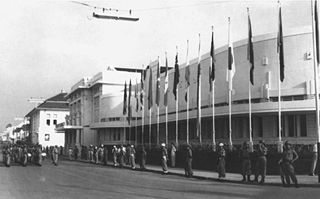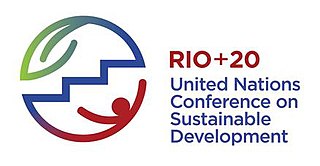
The United Nations Environment Programme (UNEP), an agency of the United Nations, coordinates the organization's environmental activities and assists developing countries in implementing environmentally sound policies and practices. It was founded by Maurice Strong, its first director, as a result of the United Nations Conference on the Human Environment in June 1972 and has overall responsibility for environmental problems among United Nations agencies; however, international talks on specialized issues, such as addressing climate change or combating desertification, are overseen by other UN organizations, like the Bonn-based Secretariat of the United Nations Framework Convention on Climate Change and the United Nations Convention to Combat Desertification. UNEP's activities cover a wide range of issues regarding the atmosphere, marine and terrestrial ecosystems, environmental governance and green economy. It has played a significant role in developing international environmental conventions, promoting environmental science and information and illustrating the way those can be implemented in conjunction with policy, working on the development and implementation of policy with national governments, regional institutions in conjunction with environmental non-governmental organizations (NGOs). UNEP has also been active in funding and implementing environment related development projects.

The Non-Aligned Movement (NAM) is a forum of 125 developing world states that are not formally aligned with or against any major power bloc. After the United Nations, it is the largest grouping of states world-wide.

Agenda 21 is a non-binding action plan of the United Nations with regard to sustainable development. It is a product of the Earth Summit held in Rio de Janeiro, Brazil, in 1992. It is an action agenda for the UN, other multilateral organizations, and individual governments around the world that can be executed at local, national, and global levels.
The United Nations Commission on Sustainable Development (CSD) was a body under the UN Economic and Social Council (ECOSOC) tasked with overseeing the outcomes of the 1992 United Nations Conference on Environment and Development/Earth Summit. It was replaced in 2013 by the High-level Political Forum on Sustainable Development, which meets both under the General Assembly every four years and the ECOSOC in other years.
Habitat II, the Second United Nations Conference on Human Settlements was held in Istanbul, Turkey from June 3–14, 1996, twenty years after Habitat I held in Vancouver in 1976. Popularly called the "City Summit", it brought together high-level representatives of national and local governments, as well as private sector, NGOs, research and training institutions and the media. Universal goals of ensuring adequate shelter for all and human settlements safer, healthier and more livable cities, inspired by the Charter of the United Nations, were discussed and endorsed.

Green Cross International is an environmentalist organization founded by former Soviet leader Mikhail Gorbachev in 1993, building upon the work started by the 1992 Earth Summit in Rio de Janeiro, Brazil.
A summit meeting is an international meeting of heads of state or government, usually with considerable media exposure, tight security, and a prearranged agenda. Notable summit meetings include those of Franklin D. Roosevelt, Winston Churchill, and Joseph Stalin during World War II. However, the term summit was not commonly used for such meetings until the Geneva Summit (1955). During the Cold War, when American presidents joined with Soviet or Chinese counterparts for one-on-one meetings, the media labelled the event as a "summit". The post–Cold War era has produced an increase in the number of "summit" events. Nowadays, international summits are the most common expression for global governance.

The first large-scale Asian–African or Afro–Asian Conference—also known as the Bandung Conference —was a meeting of Asian and African states, most of which were newly independent, which took place on 18–24 April 1955 in Bandung, Indonesia. The twenty-nine countries that participated at the Bandung Conference represented nearly one-quarter of the Earth's land surface and a total population of 1.5 billion people, roughly 54% of the Earth's population at the time.
The conference was organised by Indonesia, Burma (Myanmar), Pakistan, Ceylon, and India and was coordinated by Ruslan Abdulgani, secretary general of the Ministry of Foreign Affairs of the Republic of Indonesia.
The United Nations Conference on the Human Environment was held in Stockholm, Sweden from June 5–16 in 1972.

The 2007 United Nations Climate Change Conference took place at the Bali International Conference Centre, Nusa Dua, in Bali, Indonesia, between December 3 and December 15, 2007. Representatives from over 180 countries attended, together with observers from intergovernmental and nongovernmental organizations. The conference encompassed meetings of several bodies, including the 13th Conference of the Parties to the United Nations Framework Convention on Climate Change, the 3rd Meeting of the Parties to the Kyoto Protocol, together with other subsidiary bodies and a meeting of ministers.
The United Nations Programme of Action on the Sustainable Development of Small Island Developing States, popularly referred to as the Barbados Program of Action (BPOA), is a policy document that both: comprehensively addresses the economic, environmental, and social developmental vulnerabilities facing islands; and outlines a strategy that seeks to mitigate those vulnerabilities. It remains the only internationally approved programme specific to Small Island Developing States (SIDS) which has been collectively and unanimously endorsed by SIDS.

The 2008 United Nations Climate Change Conference took place at PIF Congress Centre, Poznań International Fair (PIF), in Poznań, Poland, between December 1 and December 12, 2008. Representatives from over 180 countries attended along with observers from intergovernmental and nongovernmental organizations.

The United Nations Conference on Sustainable Development (UNCSD), also known as Rio 2012, Rio+20, or Earth Summit 2012 was the third international conference on sustainable development aimed at reconciling the economic and environmental goals of the global community. Hosted by Brazil in Rio de Janeiro from 13 to 22 June 2012, Rio+20 was a 20-year follow-up to the 1992 United Nations Conference on Environment and Development (UNCED) held in the same city, and the 10th anniversary of the 2002 World Summit on Sustainable Development (WSSD) in Johannesburg.
Global Map is a set of digital maps that accurately cover the whole globe to express the status of global environment. It is developed through the cooperation of National Geospatial Information Authorities (NGIAs) in the world. An initiative to develop Global Map under international cooperation, the Global Mapping Project, was advocated in 1992 by Ministry of Construction, Japan (MOC) at the time.
This is a list of notable events relating to the environment in 1992. They relate to environmental law, conservation, environmentalism and environmental issues.
Chandrashekhar Dasgupta is an Indian civil servant, diplomat, writer and a former Indian ambassador to the European Union, Belgium, Luxembourg and China. Born on 2 May 1940, he entered Indian Foreign Service in 1962 and worked as a diplomat till his superannuation in 2000. During this period, he served as the Indian ambassador to China (1993–1996) and Belgium and Luxemburg and the European Union(1996–2000). Prior to his postings as an ambassador, he was the high commissioner to Singapore (1981–84) and Tanzania (1984-86) and held the vice-chair of the preparatory committees of United Nations Framework Convention on Climate Change (UNFCCC) and the United Nations Conference on Environment and Development (UNCED), popularly known as the Earth Summit, held in Rio de Janeiro in 1992.
The 2017 Arab League Summit was held in Jordan between 23 and 29 March 2017.
The Earth Summits are decennial meetings of world leaders, organized since 1972 with help of the United Nations, to help defining ways to stimulate sustainable development at the global level. The aim is to bring together the best individuals and organisations humanity can bring forward from all kind of categories of life, to identify and update what are humanity's most pressing challenges, to quantify them, identify solutions and develop a plan of action not to run into a wall. This plan of action is called Agenda 21 and implemented by many local governments under the name Local Agenda 21. The plan of action is designed as a TQM - Total Quality Manual, designed smartly and open enough, so that also organisations, companies and individuals can use it as a basis for their own plan of action and guidance not to miss out on important issue; it helps speed up understanding and identifying partners by e.g. using similar wordings and symbols. The 2000-2015 Millennium Development Goals and the 2015-2030 Global Goals are results from these Earth Summits. The first summit took place in Stockholm ([Sweden]) in 1972, the second in Nairobi (Kenya) in 1982, the third in Rio de Janeiro (Brazil) in 1992 and the fourth in Johannesburg in 2002. Last Earth Summit, called Rio+20, also took place in Rio de Janeiro in 2012.








